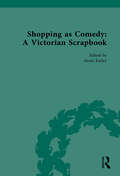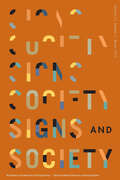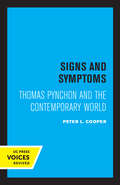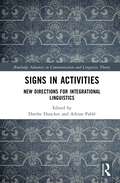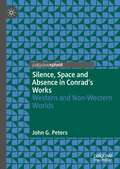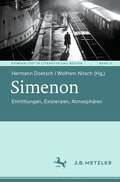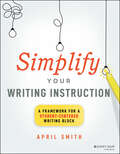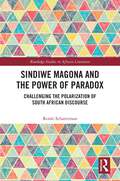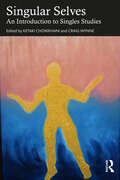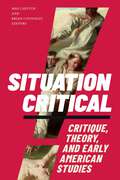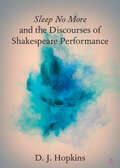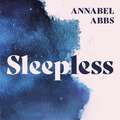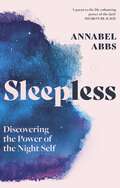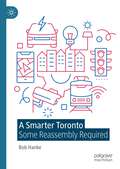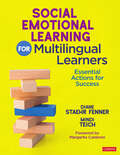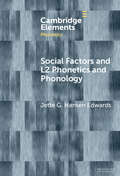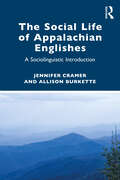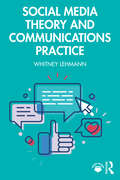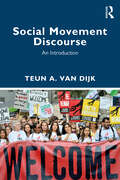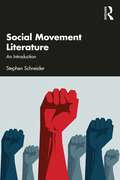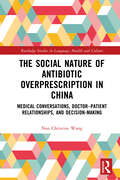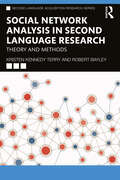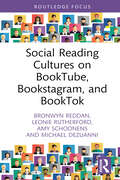- Table View
- List View
Shopping as Comedy: A Victorian Scrapbook
by Alexis EasleyThis volume is a critical edition of a Victorian scrapbook, composed of cuttings from advertising images from the 1880's. These images are arranged in hand-drawn domestic spaces and embellished with watercolour details. At the foot of each page is a handwritten running text, written by an unknown Victorian author, that provides a narrative to explain the accompanying images. The album also includes four original short stories, interspersed by twenty-three vignettes, which, like advertisements in a magazine, echo and reinforce themes in the surrounding content. The album highlights issues of concern to women at the fin de siècle: romance, marriage, shopping, and house decoration. The satirical commentary on late Victorian shopping and commodity culture provides a fascinating insight into the interests and responses of consumers during this period. The volume will be of great interest to students and scholars of literary and advertising history.
Signs and Society, volume 12 number 1 (Winter 2024)
by Signs and SocietyThis is volume 12 issue 1 of Signs and Society. Signs and Society is an open-access, multidisciplinary journal in the humanities and social sciences focusing on research that examines the role of sign processes (or semiosis) in social interaction, cognition, and cultural formations. Focusing directly on semiosis in its multiple dimensions, the journal aims to promote collaborative translation across analytical categories and technical vocabularies already established in anthropology, linguistics, semiotics, and related disciplines, and to uncover unanticipated parallels in the ways semiosis is manifest in diverse empirical domains.
Signs and Symptoms: Thomas Pynchon and the Contemporary World
by Peter L. CooperThis title is part of UC Press's Voices Revived program, which commemorates University of California Press’s mission to seek out and cultivate the brightest minds and give them voice, reach, and impact. Drawing on a backlist dating to 1893, Voices Revived makes high-quality, peer-reviewed scholarship accessible once again using print-on-demand technology. This title was originally published in 1983.
Signs in Activities: New Directions for Integrational Linguistics (Routledge Advances in Communication and Linguistic Theory)
by Dorthe Duncker Adrian PabléThis book is a collective volume bringing together scholars who share an interest in linguistics from an integrational point of view and in developing new directions for future scholarship.Integrational linguistics invites us to rethink the theoretical and methodological premises of general linguistics by drawing on a different conception of the sign and by recognizing the creativity that human communication requires. Some chapters are concerned with concepts like the sign, contextualization, activity, and integration. Although being core concepts developed by the founder of integrational linguistics, Roy Harris, they have arguably remained underdeveloped in Harris’ writings and thus call for further clarification and investigation. Other chapters are concerned with the notions of the self and the social, experience and interaction, with questions about individual agency and will, and human sociality and social organization, which all occupy a central position in integrational theory. Finally, remaining chapters focus on how scriptism and the language myth have influenced our way of thinking about communication in a broad sense.This edited collection will be of interest to a multidisciplinary readership comprising those engaged in study, teaching, and research in the humanities and social sciences, including anthropology, the arts, education, linguistics, literary studies, philosophy, psychology, and semiotics.
Silence, Space and Absence in Conrad's Works: Western and Non-Western Worlds
by John G. PetersThis book considers the relationship between sound and silence in the works of Joseph Conrad, along with their ties to Western and non-Western space. Throughout Conrad’s works, a pattern emerges where Western space is associated with sound and non-Western space is associated with silence; similarly, Western space is portrayed as full of objects and activity, whereas non-Western space is portrayed as empty. As these tales progress, though, Conrad’s characters embark on transformational journeys that cause them to reassess the world they live in and sometimes even the nature of the universe. These journeys invariably occur through encountering non-Western space, and during the course of these journeys, the dichotomy between Western space, perceived as replete with sound and activity, and non-Western space, empty of such, blurs such that the fullness of the West is revealed to be simply a surface hiding the emptiness beneath. In the end, both Western and non-Western space are revealed to be absences, as the absence of sound becomes a correlative for the emptiness of space and the emptiness of space becomes a metonym for the cosmological emptiness of nothingness.
Simenon: Ermittlungen, Existenzen, Atmosphären (Kriminalität in Literatur und Medien #5)
by Hermann Doetsch Wolfram NitschDieser Band würdigt Simenons lange unterschätztes Romanwerk in vierfacher Hinsicht. In gattungsgeschichtlicher Perspektive arbeitet er die Originalität der Ermittlerfigur Maigret sowie die Affinität der „harten Romane“ zum Existentialismus heraus. Unter subjektgeschichtlichem Aspekt legt er dar, wie die Protagonisten gerade dieser Romane mit Prozessen sozialer Modernisierung und biopolitischer Kontrolle in Konflikt geraten. In medientheoretischer Hinsicht wird beleuchtet, wie genau Simenon moderne Techniken der Untersuchung und der Überwachung beobachtet hat. Unter raumtheoretischem Gesichtspunkt schließlich behandelt er seinen ausgeprägten Sinn für Milieus und Atmosphären.
Simplify Your Writing Instruction: A Framework For A Student-Centered Writing Block
by April SmithSet up your writing block quickly and easily with a simple, research-based framework Schools need their writing instruction simplified. Most classrooms share writing time with another subject, making it difficult for students to receive the direct writing instruction they need. Between the lack of time, increased gaps in writing skills, and inconsistent writing curriculum, teachers are struggling to bring their students up to grade level. Simplify Your Writing Instruction provides you with a classroom-tested framework that helps you set up your writing block within the limited time and resources you have. Step by step, this practical guide shows you how to amplify your students’ writing skills, employ simple feedback opportunities and interventions, streamline your lessons, use simple differentiation techniques to help reach students of all ability levels, and more. Author April Smith is a former teacher who has trained more than 50,000 K-12 educators on best practices for writing instruction. While in the classroom, she learned that having simple and consistent systems in place is critical. Accordingly, none of the tasks and strategies will require you to create or prep anything complicated or time-consuming. In Simplify Your Writing Instruction, you will find easy-to-use checklists, implementation tasks, customizable templates, student writing samples, helpful tables and charts, and a simple spreadsheet that you can use to plan your lessons and modify your teaching to meet the needs of each writer. Be confident and supported in your writing instruction. Simplify Your Writing Instruction will teach you how to: Implement the Simple Pre-Assessment Process in your classroom Encourage authentic writing practice at home Differentiate your lessons to reach your Special Education, ELL, and Gifted students Integrate grammar naturally and optimize student output after each lesson Split the writing process into efficient and effective 10- to 15-minute mini-lessons Make writing a priority by incorporating writing application into other subjects Use a simple pre-assessment to get a better overall picture of what your students can do Utilize more complex strategies such as small group work and conferring Packed with expert advice and easy-to-follow strategies, Simplify Your Writing Instruction: A Framework for a Better Writing Block is a must-have resource for all K-12 educators and teachers in training.
Sindiwe Magona and the Power of Paradox: Challenging the Polarization of South African Discourse (Routledge Studies in African Literature)
by Renée SchattemanThis book examines the work of Sindiwe Magona, one of South Africa’s most prolific and groundbreaking writers, widely recognized for highlighting the everyday experiences of women and the domestic side of apartheid. A pioneer among black African women writers, she is equally respected as storyteller, advocate for children’s education, activist for HIV/AIDS awareness, and champion of indigenous languages. In this book, Renée Schatteman contends that Magona’s most important contribution comes through her refusal to choose sides in the contentious debates that have polarized public discourse following apartheid. By straddling two (or more) sides of a controversy and challenging any who do harm to others (and to the nation), regardless of their position, she blurs distinctions that are assumed to be absolute, opens new avenues of understanding, and inspires alternative visions for the future. By occupying the space of paradox, she undermines the closed epistemological structures inherited from apartheid and champions the need for interdependence, truth-telling, and dialogue. Covering her creative production over three decades (which includes novels, autobiographies and biographies, short story collections, children’s books, and literature about HIV/AIDS), this book is an essential read for Magona enthusiasts as well as for researchers of African literature and postcolonial South Africa.
Singular Selves: An Introduction to Singles Studies
by Ketaki Chowkhani and Craig WynneThis book examines, for perhaps the first time, singlehood at the intersections of race, media, language, culture, literature, space, health, and life satisfaction. It adopts an interdisciplinary approach, borrowing from sociology, literary studies, medical humanities, race studies, linguistics, demographic studies, and critical geography to understand singlehood in the world today. This collection of essays aims to establish the discipline of Singles Studies, finding new ways of examining it from various disciplinary and cultural perspectives. It begins with laying the field and then moves on to critically look at how race has shaped the way we understand singlehood in the West and how class, age, gender, privilege, and the media play a role in shaping singlehood. It argues for a need for increased interdisciplinarity within the field, for example, analyzing singlehood from the perspective of medical humanities. The volume also explores the role workplace, living arrangements, financial status, and gender play in single people’s life satisfaction. With an interdisciplinary and transnational approach, this interdisciplinary volume seeks to establish Singles Studies as a truly global discipline. This pathbreaking volume would be of interest to students and researchers of sociology, literature, linguistics, media studies, and psychology.
Situation Critical: Critique, Theory, and Early American Studies
by Max Cavitch and Brian Connolly, eds.The contributors to Situation Critical argue for the continued importance of critique to early American studies, pushing back against both reductivist neo-empiricism and so-called postcritique. Bringing together essays by a diverse group of historians and literary scholars, editors Max Cavitch and Brian Connolly demonstrate that critique is about acknowledging that we are never simply writing better or worse accounts of the past, but accounts of the present as well. The contributors examine topics ranging from the indeterminacy of knowledge and history to Black speculative writing and nineteenth-century epistemology, the role of the unconscious in settler colonialism, and early American writing about masturbation, repression, religion, and secularism and their respective influence on morality. The contributors also offer vital new interpretations of major lines of thought in the history of critique—especially those relating to Freud and Foucault—that will be valuable both for scholars of early American studies and for scholars of the humanities and interpretive social sciences more broadly.Contributors. Max Cavitch, Brian Connolly, Matthew Crow, John J. Garcia, Christopher Looby, Michael Meranze, Mark J. Miller, Justine S. Murison, Britt Rusert, Ana Schwartz, Joan W. Scott, Jordan Alexander Stein
Sleep No More and the Discourses of Shakespeare Performance (Elements in Shakespeare Performance)
by null D. J. HopkinsThis Element focuses on Sleep No More, theatre adaptation of Macbeth produced by the British company Punchdrunk. This Element frames the Shakespeare adaptation as part of a system of ghostly citationality through which audiences understand the significance of the past in performances today. Hopkins introduces the concept of “uncanny spectatorship” to describe audience practice in Sleep No More and other performance contexts. The Element positions experiences like Sleep No More as forms of critical inquiry, and, despite its seemingly analog format, Sleep No More is discussed as a valuable site for media research. Ultimately, Sleep No More and the Discourses of Shakespeare Performance Sleep No More offers an opportunity to explore a set of concepts that are significant to the subject of Shakespeare Performance and to consider the ways in which audiences interact with bodies, spaces, text, and media.
Sleepless: Discovering the Power of the Night Self
by Annabel Abbs'Sleepless has changed how I feel about sleep . . . I was captivated' The Times, Book of the Week'This book will inspire you to get up, light a candle, and experience your own Night Self' Financial TimesTHE NIGHT SELF IS: CREATIVE. CURIOUS. VULNERABLE. ENCHANTED. COURAGEOUS.In the winter of 2020, Annabel Abbs experienced a series of bereavements. As she grieved, she kept busy by day, but at night sleep eluded her. And yet her sleeplessness led to a profound and unexpected discovery: her Night Self. As the night transformed into a place of creativity and liberation, Annabel found she wasn't alone. From the radical fifteenth-century philosopher Laura Cereta and subversive artist Louise Bourgeois, to Virginia Woolf and the activist Peace Pilgrim, women have long found sanctuary, inspiration and courage in darkness.Drawing on the latest science, which shows we are more imaginative, open-minded and reflective at night, Annabel set out to discover the potential of her Night Self. Sleepless follows her journey, from midnight hikes to starlit swims, from Singapore, the brightest city on Earth, to the darkest corner of the Arctic Circle, and finally to that most elusive of places - sleep.A moving, revelatory voyage into the dark, Sleepless invites us to feel less anxious about our sleep, and to embrace the possibilities of the night.
Sleepless: Discovering the Power of the Night Self
by Annabel Abbs'Sleepless has changed how I feel about sleep . . . I was captivated' The Times, Book of the Week'This book will inspire you to get up, light a candle, and experience your own Night Self' Financial TimesTHE NIGHT SELF IS: CREATIVE. CURIOUS. VULNERABLE. ENCHANTED. COURAGEOUS.In the winter of 2020, Annabel Abbs experienced a series of bereavements. As she grieved, she kept busy by day, but at night sleep eluded her. And yet her sleeplessness led to a profound and unexpected discovery: her Night Self. As the night transformed into a place of creativity and liberation, Annabel found she wasn't alone. From the radical fifteenth-century philosopher Laura Cereta and subversive artist Louise Bourgeois, to Virginia Woolf and the activist Peace Pilgrim, women have long found sanctuary, inspiration and courage in darkness.Drawing on the latest science, which shows we are more imaginative, open-minded and reflective at night, Annabel set out to discover the potential of her Night Self. Sleepless follows her journey, from midnight hikes to starlit swims, from Singapore, the brightest city on Earth, to the darkest corner of the Arctic Circle, and finally to that most elusive of places - sleep.A moving, revelatory voyage into the dark, Sleepless invites us to feel less anxious about our sleep, and to embrace the possibilities of the night.
A Smarter Toronto: Some Reassembly Required
by Bob HankeThis book bridges media, technocultural, urban, and journalism studies to examine the role of journalism in relation to a smart city project on Toronto’s waterfront. From the announcement of the public-private partnership called Sidewalk Toronto to the project’s termination, a mediatized controversy unfolded. Through an assemblage approach to this project and a case study of The Globe and Mail and the Toronto Star, it follows the actors and chronicles the Quayside project story as a conversation about the promise and perils of a future “smart” neighbourhood. In the news of Waterfront Toronto, Sidewalk Labs, other actors, events, and developments, there were multiple voices and views, interpretations and arguments, that manifested conflicting interests and values. As a locally situated actor, journalism produced a porous discourse that expressed a proposeand- public pushback movement. This work of articulating mediation conditioned the project’s alteration and dissolution within asymmetrical relations of power. In addition to a wave of opposition that inflected the project’s enactment, a time lag between project time and governmental policymaking made the controversy over this future urban space intractable. With their residual symbolic power, quality journalism contributed to dialogical urban learning.
Social Emotional Learning for Multilingual Learners: Essential Actions for Success
by Diane Staehr Fenner Mindi TeichFoster multilingual learners’ academic success, wellbeing, agency, and belonging Though multilingual learners (MLs) comprise nearly 25% of the school-age population, the most widely-used social emotional learning (SEL) frameworks and programs lack an intentional focus on these students’ unique strengths and challenges. To foster MLs’ academic success and wellbeing, educators must consider students’ cultures, languages, assets, expectations, norms, and life experiences when integrating SEL practices. In this groundbreaking book, Dr. Diane Staehr Fenner and Mindi Teich break down how each of the five competencies in the Collaborative for Academic, Social, and Emotional Learning (CASEL) SEL framework can be implemented with ML success in mind. Staehr Fenner and Teich’s practical and engaging guide provides SEL considerations that are unique to MLs, relevant research, easy-to-implement educator actions, and tools to seamlessly integrate SEL practices into content and language instruction. Additional features include: Tools and practical strategies educators can apply immediately Programmatic and systemic considerations that impact SEL for MLs Examples of successful SEL strategies for MLs currently being used in classrooms Ample opportunities for reflection and application in each chapter Templates to prioritize and integrate SEL for MLs into teaching practices MLs thrive when they are validated and supported to achieve their goals, empathize with others, build relationships, and make responsible decisions. The essential actions presented in this guide will enable you–regardless of your role or prior experience with SEL–to empower MLs to achieve academic and lifelong success.
Social Emotional Learning for Multilingual Learners: Essential Actions for Success
by Diane Staehr Fenner Mindi TeichFoster multilingual learners’ academic success, wellbeing, agency, and belonging Though multilingual learners (MLs) comprise nearly 25% of the school-age population, the most widely-used social emotional learning (SEL) frameworks and programs lack an intentional focus on these students’ unique strengths and challenges. To foster MLs’ academic success and wellbeing, educators must consider students’ cultures, languages, assets, expectations, norms, and life experiences when integrating SEL practices. In this groundbreaking book, Dr. Diane Staehr Fenner and Mindi Teich break down how each of the five competencies in the Collaborative for Academic, Social, and Emotional Learning (CASEL) SEL framework can be implemented with ML success in mind. Staehr Fenner and Teich’s practical and engaging guide provides SEL considerations that are unique to MLs, relevant research, easy-to-implement educator actions, and tools to seamlessly integrate SEL practices into content and language instruction. Additional features include: Tools and practical strategies educators can apply immediately Programmatic and systemic considerations that impact SEL for MLs Examples of successful SEL strategies for MLs currently being used in classrooms Ample opportunities for reflection and application in each chapter Templates to prioritize and integrate SEL for MLs into teaching practices MLs thrive when they are validated and supported to achieve their goals, empathize with others, build relationships, and make responsible decisions. The essential actions presented in this guide will enable you–regardless of your role or prior experience with SEL–to empower MLs to achieve academic and lifelong success.
Social Factors and L2 Phonetics and Phonology (Elements in Phonetics)
by null Jette G. Hansen EdwardsThis Element provides readers with a detailed overview of the social factors that affect second language (L2) phonology acquisition and use. Through a state-of-the art synthesis of the relevant literature, this Element addresses the following questions: What do we mean by social factors? Which social factors have been investigated in research on L2 phonological acquisition and use? How and why do social factors affect L2 phonological acquisition (production and perception) and use? What are the implications of the social factor findings for teaching L2 pronunciation? The Element answers these questions through a synthesis of key findings in research on social factors and L2 phonology. Conclusions and implications for teaching, as well as key readings and references, follow the research synthesis.
The Social Life of Appalachian Englishes: A Sociolinguistic Introduction
by Jennifer Cramer Allison BurketteAppalachian Englishes (AEs) possess an array of linguistic features that distinguish them from other American Englishes, yet the rich history of language in the United States has created a wealth of linguistic resources through factors such as immigration and contact, providing the environment for AEs to grow and adapt in ways that are also similar to other varieties of English. AEs have a long history of representation in linguistic literature, but until now no single work has examined the interplay of language production and perception with an eye toward the role that language plays in the construction of personal and social identities.The Social Life of Appalachian Englishes takes a sociolinguistic/sociocultural approach to exploring specific linguistic features highlighted in the Linguistic Atlas Projects and the social life of Appalachian varieties in terms of perceptions and use. Focusing on the single theme of the social life of language in Appalachia, the book aims to explore the implications of the kinds of variation found, reinforce the notion that social meaning and variation are inseparable, and illustrate how linguistic production and perception are interrelated. It uses new data to amplify this theme, presenting a novel combination of data from different sociolinguistic traditions (specifically, perceptual dialectology and traditional atlas-style dialectology). Opportunities for engagement are provided through QR codes linking to additional resources and discussion questions and exercises at the end of each chapter.This book is designed for students and researchers interested in general linguistics, sociolinguistics, American Englishes, language variation, linguistic anthropology, and Appalachian studies.
Social Media Theory and Communications Practice
by Whitney LehmannFusing the academic with the applied, this book provides a comprehensive introduction to social media for future communications professionals.While most social media texts approach the subject through either a theoretical, scholarly lens or a professional, practical lens, this text offers a much-needed linkage of theory to the practical tactics employed by social media communicators. Concise and conversational chapters break down the basics of both social media theory and practice and are complemented by sidebars written by scholars and industry professionals, chapter summaries and end-of-chapter exercises.This book is ideal for introductory social media courses in communication, public relations and mass communication departments, as well as courses in digital media and public relations.Online resources include social media writing templates, sample posts and content calendar templates. Please visit www.routledge.com/9781032185873.
Social Movement Discourse: An Introduction
by Teun A. van DijkThis is both the first systematic introduction to Discourse Studies for students and scholars of social movements and a study of discourses on the European "refugee crisis", by leading theorist, Teun A. van Dijk. Concrete examples of different kinds of discourse are vital for the study of social movements because their activities are not limited to such well-known forms of contention as marches, occupations or strikes, but also daily discursive activities, such as meetings, assemblies, interviews, press conferences, manifestos, pamphlets, banners, graffiti, websites, blogs, social media posts and everyday talk. This book proposes that empirical analyses of these discourses should go beyond the popular but vague notion of "frame" and engage in more detailed and explicit analyses of the text and talk of social movements. This is a much-needed introduction to the most important structures of discourse and a detailed theoretical account of the notion of "solidarity" defining the Refugees Welcome movement.
Social Movement Discourse: An Introduction
by Teun A. van DijkThis is both the first systematic introduction to Discourse Studies for students and scholars of social movements and a study of discourses on the European “refugee crisis”, by leading theorist, Teun A. van Dijk.Concrete examples of different kinds of discourse are vital for the study of social movements because their activities are not limited to such well-known forms of contention as marches, occupations or strikes, but also daily discursive activities, such as meetings, assemblies, interviews, press conferences, manifestos, pamphlets, banners, graffiti, websites, blogs, social media posts and everyday talk.This book proposes that empirical analyses of these discourses should go beyond the popular but vague notion of “frame”and engage in more detailed and explicit analyses of the text and talk of social movements.This is a much-needed introduction to the most important structures of discourse and a detailed theoretical account of the notion of “solidarity” defining the Refugees Welcome movement.
Social Movement Literature: An Introduction
by Stephen SchneiderSocial Movement Literature introduces readers to the study of those cultural texts that have come to define modern social movements. Looking at movements such as the US civil rights movement, gay liberation movement, environmental movement, and contemporary movement such as #metoo and Black Lives Matter, this volume focuses not just on the texts that social movements have produced, but also on those that have inspired and been inspired by those movements. As such, Social Movement Literature seeks to address a number of key questions: how do social movements develop and present not just their goals, but also their broader identities, using texts and other media? How are these movement texts received and further disseminated? Are there common features across movement texts? How and why do some of these texts continue to resonate today? By combining both textual and historical approaches to the analysis of social movements, this volume aims to give readers both an understanding of how social movements emerge and why they remain both political and culturally relevant today.
The Social Nature of Antibiotic Overprescription in China: Medical Conversations, Doctor–Patient Relationships, and Decision-Making (Routledge Studies in Language, Health and Culture)
by Nan Christine WangOffering a rarely seen glimpse into the realities of one of the biggest global public health crises in modern time, Wang’s book focuses on doctor–patient interactions in China to demonstrate the potential effects of health communication, doctor–patient relationship, and a matrix of social factors on overprescription of antibiotics.Based on a community-based survey, the book describes empirical findings regarding the high prevalence of non-prescribed antibiotics use for common colds among children in China. It covers the potential effects of overprescription on caregivers' attitudes and how physicians make prescribing decisions in medical consultations. Drawing from evidence in medical interaction data, readers are introduced to further empirical findings regarding the communicative behaviors that patient caregivers use to pressure for antibiotic prescriptions in real medical consultations. Following this, Wang reports findings regarding the communicative behaviors that physicians use to make treatment recommendations and caregivers use to launch treatment negotiations, leading to a discussion of the effect of the doctor–patient relationship on antibiotic overprescription. The book culminates in practice recommendations and provides teaching scenarios in which physicians successfully engage the caregivers into conversations to shape their expectations for antibiotic prescriptions in medical consultations.An important resource for scholars and students in health communication, linguistics, medical humanities, and medical sociology. Practitioners who are interested in understanding and improving clinical practices as well as policymakers aiming to combat antibiotic resistance will also find this book useful.
Social Network Analysis in Second Language Research: Theory and Methods (ISSN)
by Kristen Kennedy Terry Robert BayleyThis text is the first holistic research overview and practical methodological guide for social network analysis in second language acquisition, examining how to study learner social networks and how to use network data to predict language learner behavior and identity.Authors Kristen Kennedy Terry and Robert Bayley lay out the history of social network analysis in sociolinguistics, discuss the state of the art in empirical findings in applications to language acquisition, offer how-to guidance and best practices for planning, conducting, and understanding this research, and authoritatively set the agenda for future work.With a variety of helpful features like case studies, suggested research projects, discussion questions, and recommended further reading, this book will be an invaluable resource to students and researchers of second language acquisition, sociolinguistics, education, and beyond.
Social Reading Cultures on BookTube, Bookstagram, and BookTok
by Bronwyn Reddan Leonie Rutherford Amy Schoonens Michael DezuanniThis book examines the reading cultures developed by communities of readers and book lovers on BookTube, Bookstagram, and BookTok as an increasingly important influence on contemporary book and literary culture. It explores how the affordances of social media platforms invite readers to participate in social reading communities and engage in creative and curatorial practices that express their identity as readers and book lovers.The interdisciplinary team of authors argue that by creating new opportunities for readers to engage in social reading practices, bookish social media has elevated the agency and visibility of readers and book consumers within literary culture. It has also reshaped the cultural and economic dynamics of book recommendations by creating a space in which different actors are able to form an identity as mediators of reading culture.Concise and accessible, this introduction to an increasingly central set of literary practices is essential reading for students and scholars of literature, sociology, media, and cultural studies, as well as teachers and professionals in the book and library industries.
